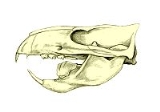
Ptilodontoidea
Encyclopedia
Ptilodontoidea is a group of extinct mammals from the Northern Hemisphere
.
They were generally small, somewhat rodent
-like creatures of the extinct order
Multituberculata
.
Some of these genera boast a great many species, though remains are generally sparse.
Ptilodus
is among the best known, and there's a tendency to depict it as an analog of a squirrel
.
Upper Cretaceous
remains are known from North America and Europe. Later representatives (Paleocene
- Eocene
) hail from North America, Europe and Asia. These were some of the last multituberculates, and they are within the suborder Cimolodonta
.
The superfamily is further divided into the following families:
The affinities of Neoliotomus
are less clear, though it seems to fit somewhere within the superfamily.
Northern Hemisphere
The Northern Hemisphere is the half of a planet that is north of its equator—the word hemisphere literally means “half sphere”. It is also that half of the celestial sphere north of the celestial equator...
.
They were generally small, somewhat rodent
Rodent
Rodentia is an order of mammals also known as rodents, characterised by two continuously growing incisors in the upper and lower jaws which must be kept short by gnawing....
-like creatures of the extinct order
Order (biology)
In scientific classification used in biology, the order is# a taxonomic rank used in the classification of organisms. Other well-known ranks are life, domain, kingdom, phylum, class, family, genus, and species, with order fitting in between class and family...
Multituberculata
Multituberculata
The Multituberculata were a group of rodent-like mammals that existed for approximately one hundred and twenty million years—the longest fossil history of any mammal lineage—but were eventually outcompeted by rodents, becoming extinct during the early Oligocene. At least 200 species are...
.
Some of these genera boast a great many species, though remains are generally sparse.
Ptilodus
Ptilodus
Ptilodus is a genus of mammals from the extinct order of Multituberculata, and lived during the Paleocene in North America.Ptilodus was a relatively large multituberculate of in length, which is about the same size as a squirrel...
is among the best known, and there's a tendency to depict it as an analog of a squirrel
Squirrel
Squirrels belong to a large family of small or medium-sized rodents called the Sciuridae. The family includes tree squirrels, ground squirrels, chipmunks, marmots , flying squirrels, and prairie dogs. Squirrels are indigenous to the Americas, Eurasia, and Africa and have been introduced to Australia...
.
Upper Cretaceous
Cretaceous
The Cretaceous , derived from the Latin "creta" , usually abbreviated K for its German translation Kreide , is a geologic period and system from circa to million years ago. In the geologic timescale, the Cretaceous follows the Jurassic period and is followed by the Paleogene period of the...
remains are known from North America and Europe. Later representatives (Paleocene
Paleocene
The Paleocene or Palaeocene, the "early recent", is a geologic epoch that lasted from about . It is the first epoch of the Palaeogene Period in the modern Cenozoic Era...
- Eocene
Eocene
The Eocene Epoch, lasting from about 56 to 34 million years ago , is a major division of the geologic timescale and the second epoch of the Paleogene Period in the Cenozoic Era. The Eocene spans the time from the end of the Palaeocene Epoch to the beginning of the Oligocene Epoch. The start of the...
) hail from North America, Europe and Asia. These were some of the last multituberculates, and they are within the suborder Cimolodonta
Cimolodonta
The Cimolodonta are a taxon of extinct mammals that lived from the Cretaceous to the Eocene. They were some of the more derived members of the extinct order Multituberculata. They probably lived something of a rodent-like existence until their ecological niche was assumed by true rodents...
.
The superfamily is further divided into the following families:
- NeoplagiaulacidaeNeoplagiaulacidaeNeoplagiaulacidae is a family of mammal within the extinct order Multituberculata. Fossil remains are known from the Upper Cretaceous through the Eocene. Representatives have been found in North America, Europe and Asia....
- 10 genera; - PtilodontidaePtilodontidaePtilodontidae is a family of primitive mammals within the extinct order Multituberculata. Representatives are known from the Upper Cretaceous and Paleocene of North America....
- 4 genera; - CimolodontidaeCimolodontidaeCimolodontidae is a family of fossil mammals within the extinct order Multituberculata. Representatives are known from the Upper Cretaceous and Paleocene of North America. There is some doubt as to whether Cimolodon is within this taxon. If not, the name of the family would still be valid...
- possibly 3 genera.
The affinities of Neoliotomus
Neoliotomus
Neoliotomus is a genus of North American mammal from the Paleocene. It existed in the age immediately following the extinction of the last dinosaurs and was a member of the extinct order Multituberculata. It lies within the suborder Cimolodonta and the superfamily Ptilodontoidea...
are less clear, though it seems to fit somewhere within the superfamily.

